5 Tips for Correcting Your Child’s Pencil Grasp
Affiliate and Referral links are used below to promote products I love and recommend. I receive a commission on any purchases made through these links. Please see my disclosure policy for more details. As an Amazon Associate, I earn from qualifying purchases.
A question I often get is how to correct a child’s pencil grip once they have already established a grasp. Usually, it is easiest to try and correct a pencil grasp before 2nd or 3rd grade. After that time period, a child’s pencil grasp is a well-established habit that is hard to break. Today I am sharing 5 tips on how you can correct your child’s pencil grasp.
Post updated Feb. 2023.
Table of contents
What is a correct pencil grip called?
You may see pencil grip and pencil grasp used interchangeably. However, for the purpose of this post, I am referring to the way the child actually holds the pencil as “pencil grasp”. A pencil grip would be an additional tool used on the pencil to help promote efficient grasp. I'll address pencil grips specifically as one of the tips below.
There are a few types of functional grasps. It's important to remember that children are still developing their grasp until age 5 and older. A 3-year-old is not going to be developmentally ready for these types of grasps.
The two types of efficient or functional pencil grasps are a dynamic tripod (3-finger grasp), and a dynamic quadrupod grasp (4-finger grasp).
You can read more about pencil grasp development here.
At what age should you correct a child's pencil grip?
You should always model an efficient/functional grasp that is developmentally appropriate for your child's age. However, if you do start to notice habits forming, it's important to address them.
Pre-Kindergarten and the beginning of Kindergarten are the perfect times to help correct a child’s grip, typically because they are still learning how.
If your child is older, it's important to look at other factors that may be affecting their pencil grasp, such as hand strength, writing speed, and legibility. If your child is complaining of hand fatigue when writing and has slower writing speed or legibility issues, then addressing any pencil grasp concerns could be helpful.
It's important to have any concerns addressed by an Occupational Therapist. They will be able to look for any underlying issues that could be affecting your child's handwriting. That could include their pencil grasp or it could be something else.
5 Tips for Correcting Your Child's Pencil Grasp
Here are some ways you can address pencil grasp concerns.
1. Focus on Fine Motor and Hands-On Activities NOT Pencil and Paper.
I know it seems counterproductive to not have them practice with a pencil and paper to write, but for children of this age, working on fine motor activities and strengthening the fingers for handwriting is going to get you a lot farther than just route practicing with pencil and paper.
You particularly want to focus on fine motor activities that require them to imitate how to hold a pencil or strengthen the fingers used in a pincer grasp.
Here are some ideas:
- Activities for Fine Motor Skills Development
- 12 Fun Ways to Practice Handwriting with Preschoolers
- 6 Pre-writing Activities for Preschoolers
2. Using pom-poms, coins, or beads in the last two fingers.
This one is fairly self-explanatory. The fingers that are not on the pencil hold onto a small pom-pom, coin, or bead. This reminds the child to keep those fingers closed in their hand with the correct fingers on the pencil.
3. “Go” & “Stop” fingers.
This was a little trick I used when I was working in the school system as an Occupational Therapy Assistant. I had a sign with a picture of the green “go” fingers for writing and a red stop sign with a picture of the “stop” fingers. “Go” fingers are the fingers on the pencil, and “stop” fingers go in the hand.
When I saw a child using the wrong grasp, I would remind them to use their “Go” fingers. This worked pretty well with a lot of my kiddos. You could also make a sign to have hanging or on the child’s desk as a visual reminder instead of always verbally reminding them.
4. Using smaller or fatter pencils.
Typically a suggestion given is to use smaller, shorter pencils or crayons to promote a good grasp. However, some children really do benefit from the thicker, fatter pencils, particularly if they have a weaker hand grasp. They may have a hard time feeling the smaller size pencils or being able to put the proper amount of pressure on them.
As a general rule, however, little fingers should get little pencils. I like using golf-size pencils, especially for preschoolers, and even those in Kindergarten. I always have them on hand though, no matter how old the child is.
Experiment with different types of writing utensils. Pencils with a triangle shape to them can also help. You can also find triangle pencil grips, but also read my thoughts on pencil grips below.
I will also note that the only way to really know what type of pencil will work is to get the advice of an Occupational Therapist who can assess your child’s fine motor skills and make a professional opinion based on their evaluation. If you feel your child truly has a delay in fine motor skills and handwriting, please seek the help of a professional and don’t try to treat them yourself.
5. Pencil grips as a last resort.
The reason I use pencil grips as a last resort is that many children lose them or they just become more of a distraction than a help, I have found. However, depending on the type of grip they can be beneficial.
A couple of my favorites are the Grotto grip or the training grips. The grotto grip typically works better with older children, than the training grip with younger ones.
Again, it is best to have a professional Occupational Therapist assess which grips could be helpful for your child’s situation. But here is a good post to get you started.
Pencil Grips 101 – The Anonymous OT
You May Also Like:

Heather Greutman, COTA
Heather Greutman is a Certified Occupational Therapy Assistant with experience in school-based OT services for preschool through high school. She uses her background to share child development tips, tools, and strategies for parents, educators, and therapists. She is the author of many ebooks including The Basics of Fine Motor Skills, and Basics of Pre-Writing Skills, and co-author of Sensory Processing Explained: A Handbook for Parents and Educators.

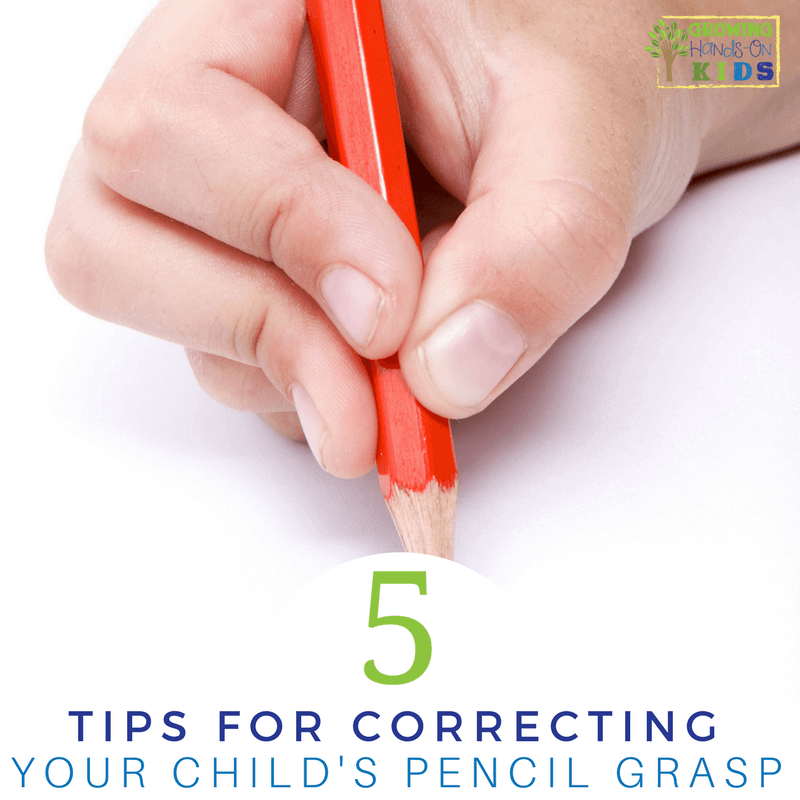
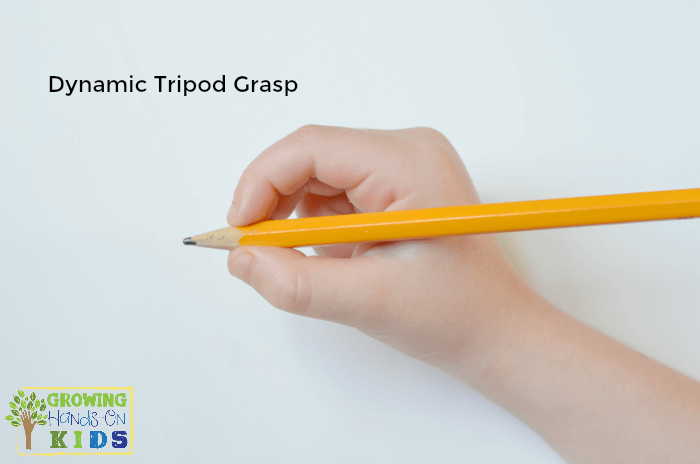
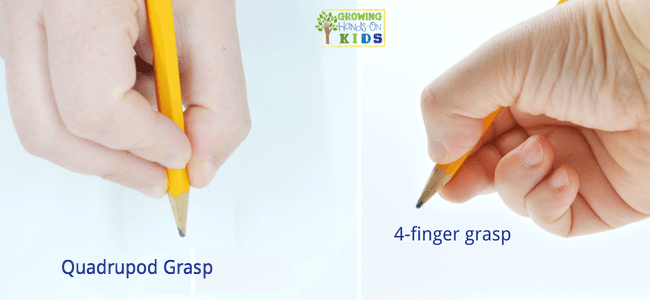


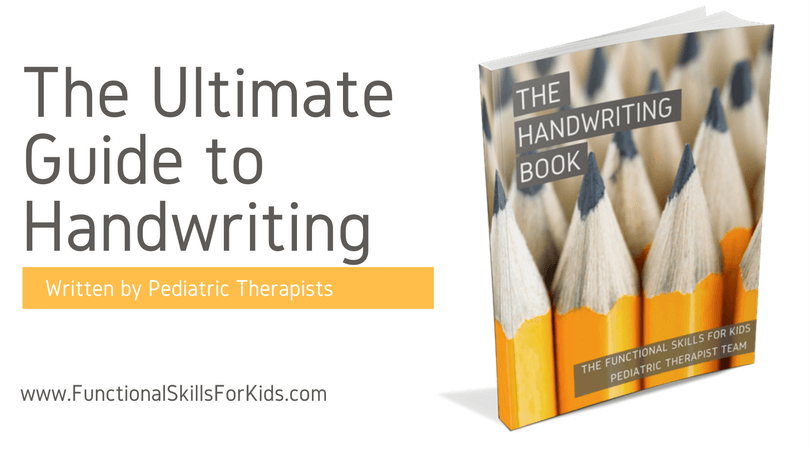
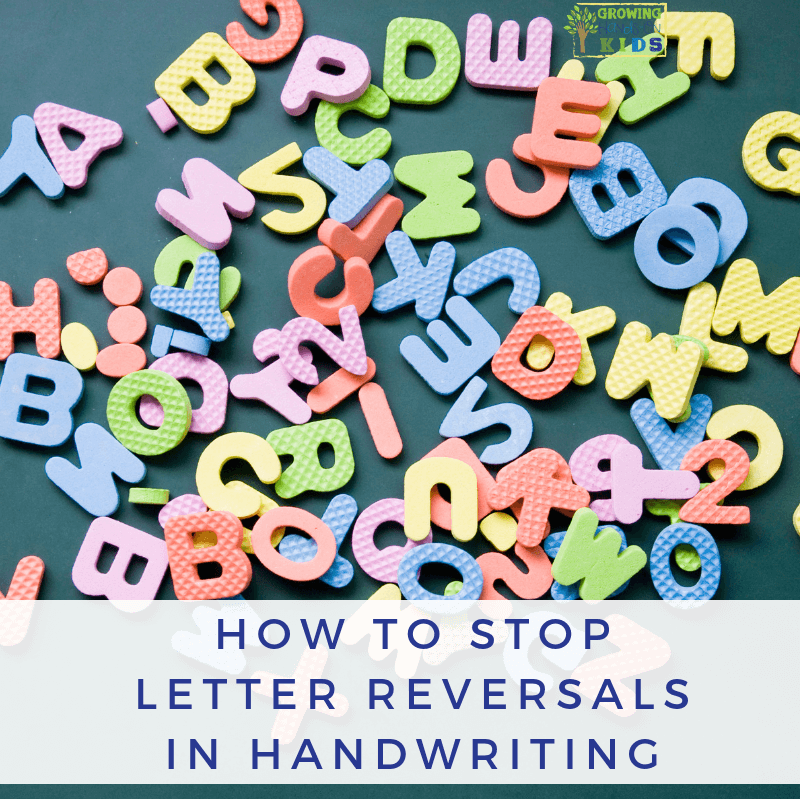
Hello. My son is 14 with autism and has lost his proper pencil grasp due to being out of practice. How can I correct it? Pls help. Thanks.
I always recommend working on a vertical surface, especially for children under 5 years. You get wrist extension, and often immediately a more mature grasp. Paint with water on a block wall, draw with chalk on the wall, tape paper to the wall or to an easel.
Great suggestions! Thanks for sharing.
What are the effects of not correcting the pencil grip? For instance, if the child holds his or her pencil wrong but still can print very legibly and clearly?
In the main illustration of your article you show a child pinching a pencil with three fingers. Isn’t the optimal grip where the pencil is held with the thumb and forefinger while resting on the middle finger?
Thank you,
Connie
Hi Connie,
Yes, the tripod grasp is the optimal grasp, however when testing for hand grasp and fine motor skills, most fine motor tests also consider the quadruped grasp (the one pictured above) a typical grasp and do not mark off points for it. I actually write with a quadruped grasp myself.
Thank you for the handwriting grasp tips. My DD is a lefty and is struggling to hold and write her name with a good grasp. I have been trying new techniques and I came across the “Aligator Bite”. That’s when you pretend to bite the pencil like an aligator, but then the alligator puckers it’s lips as if it doesn’t like the taste. It sounds strange but is a helpful trick. I stopped by from The CMN Link-up.
Thanks Rachel! Yes, I have heard of that before, it’s a great tip too!